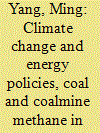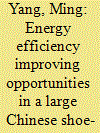|
|
|
Sort Order |
|
|
|
Items / Page
|
|
|
|
|
|
|
| Srl | Item |
| 1 |
ID:
088950


|
|
|
|
|
| Publication |
2009.
|
| Summary/Abstract |
The Chinese government has made many energy policies on coal, and coalmine methane (CMM) use. However, not all of these policies have effects or positive impacts. For example, it has been quite a few years since the national government made policies to encourage coalmine methane power to be sold to the grid. Practice showed that not any kilowatt of electricity was sold from a coalmine methane power plant to the grid in Sichuan and Guizhou Provinces as of December 2008. The objectives of this paper are to review and evaluate the Chinese government energy and climate policies that are related to coal and coalmine methane, analyze relevant policy barriers, and make recommendations to overcome these barriers and avoid policy failures. This paper provides the literature review, challenges, resources, policies and other updated information on China's CMM recovery and utilization. The paper concludes that China needs to further reform its energy and environment management system, engage provincial governments in CMM capture and use activities, and provide incentives to qualified engineers and skilled workers to work in remote coal mining areas. This paper transfers key messages to policy makers for them to make better CMM capture and use policies.
|
|
|
|
|
|
|
|
|
|
|
|
|
|
|
|
| 2 |
ID:
093520


|
|
|
|
|
| Publication |
2010.
|
| Summary/Abstract |
Energy consumption and energy intensity reduction opportunities are quite different from one enterprise to another. It is necessary to understand how much energy is used at individual enterprise, where the most energy is consumed and what the best opportunities are to invest in energy efficiency. Auditing energy efficiency was recently undertaken in one of the top 1000 largest Chinese enterprises. The objectives of this paper are to fill a gap in the literature of auditing energy efficiency for a Chinese manufacturing enterprise and to share the audited energy efficiency results. This paper concludes that if the enterprise invests USD 1.9 million to improve energy efficiency, the investment will be recovered in about 18 months. The net present value of the investment would be about USD 9.8 million at a discount rate of 12%. The investment will reduce a large amount of energy consumption at the enterprise based on its figures in 2008, including 15% of electricity, 40% of fuel oil, and 54% of diesel. Carbon reduction is also very cost-effective. Investment of one dollar in the enterprise will help cut carbon emission by 7.95 kg per year and generate $5.3 net revenue in the economic lifetime of the invested technology.
|
|
|
|
|
|
|
|
|
|
|
|
|
|
|
|
| 3 |
ID:
099204


|
|
|
|
|
| Publication |
2010.
|
| Summary/Abstract |
In the last quarter of the 20th century, many power companies used the integrated resource planning (IRP) approach in power expansion planning. Today, very few power companies use this approach because of the split between the power generation and distribution activities. It seems that, in some countries, long-term power system expansion planning has become a task of the central government. To help the government in this area, this paper proposes a new approach called the integrated resource strategic planning (IRSP). When combined with a smart grid, this approach can replace the IRP for the government's power sector expansion. This paper introduces the necessity and possibility of using this new approach, presents a framework on how to use the approach, and justifies the effectiveness of this approach against the traditional power planning approach, with a case study in China. This paper concludes that if China follows the IRSP approach, it may be able to avoid or postpone up to 69 GW of power generation in the period 2009-2015. These measures could help mitigate 201.8 million tons of carbon dioxide (CO2), 0.816 million tons of sulfur dioxide (SO2), and 0.946 million tons of nitrogen oxide (NOx).
|
|
|
|
|
|
|
|
|
|
|
|
|
|
|
|
| 4 |
ID:
111095


|
|
|
|
|
| Publication |
2012.
|
| Summary/Abstract |
Energy efficiency in industrial boiler steam systems can be very low due to old technologies, improper design and non-optimal operation of the steam systems. Solutions include efficiency assessments and investments in steam system optimizations, education and training for operators of the systems. This paper presents case studies on assessing and investing in boiler steam systems in China and Vietnam. Methodologies and approaches for data collection and analyses were designed specifically for each of the two countries. This paper concludes: (1) investing in energy efficiency in industrial boiler steam system in China and Vietnam are cost effective; (2) government should not sent national energy efficiency standards lower than that of energy companies or energy equipment manufactures.
|
|
|
|
|
|
|
|
|
|
|
|
|
|
|
|
| 5 |
ID:
088693


|
|
|
| 6 |
ID:
094291


|
|
|
|
|
| Publication |
2010.
|
| Summary/Abstract |
China has set an ambitious target to increase its wind power capacity by 35 GW from 2007 to 2020. The country's hunger for clean power provides great opportunities for wind energy investors. However, risks from China's uncertain electricity market regulation and an uncertain energy policy framework, mainly due to uncertain Clean Development Mechanism (CDM) benefits, prevent foreign investors from investing in China's wind energy. The objectives of this paper are to: (1) quantify wind energy investment risk premiums in an uncertain international energy policy context and (2) evaluate the impact of uncertain CDM benefits on the net present values of wind power projects. With four scenarios, this study simulates possible prices of certified emissions reductions (CERs) from wind power projects. Project net present values (NPVs) have been calculated. The project risk premiums are drawn from different and uncertain CER prices. Our key findings show that uncertain CDM benefits will significantly affect the project NPVs. This paper concludes that the Chinese government needs revising its tariff incentives, most likely by introducing fixed feed-in tariffs (FITs), and re-examining its CDM-granting policy and its wind project tax rates, to facilitate wind power development and enable China to achieve its wind energy target.
|
|
|
|
|
|
|
|
|
|
|
|
|
|
|
|
|
|
|
|
|